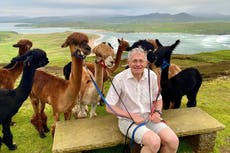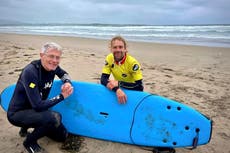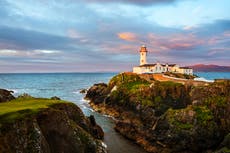Backdrops, Banshees and Beatles: discover the wonders of Ireland’s wild west
Simon Calder discovers first hand why the north west coast of Ireland has managed to provide inspiration and respite for authors, musicians and movie makers for so many years
If even the Wild Atlantic Way isn’t remote enough for you, turn west to the Mullet – a T-shaped peninsula pointing down into the Atlantic. On the sheltered eastern side, you have Ellie Beach. To the wild west, the roaring Atlantic.
The Spanish Armada and Norwegian Whalers found safe havens here, and the Mullet was also a departure point for emigrants to North America. Blue flag beaches and wild walking territory line the journey to the southern tip of the Mullet – which ends at Blacksod Harbour.
Blacksod Lighthouse, the peninsula’s handsome punctuation mark, played a crucial role in one of the most momentous decisions of the Second World War: when to launch Operation Overlord – the D-Day invasion of occupied France in June 1944.
The Allies needed accurate predictions of sea conditions in the Channel, and relied on weather reports from the Sweeney family – who were running the Lighthouse at the far west of Europe. The invasion was due to take place on 5 June, but they reported low pressure jeopardising its success. D-Day was postponed by 24 hours.
Their descendent, Vincent Sweeney, says that while the location might feel like the end of the world, it is globally connected.
“We’re not so isolated in one way. It’s a haven when some people are in distress at sea; we look after them.” Once again, he uses a phrase I heard many times on our journey: "it’s in our blood.”
The Mullet feels like an island, but isn’t. In contrast, Achill is an island – the largest isle off the coast of Ireland – yet you can reach it with a bridge across the Atlantic, or at least a short stretch of it. The arched span takes you to one of the most special places I know. The road snakes along the side of an ancient cliff, which, over aeons, is crumbling into the ocean.
The writer Graham Greene came to Achill Island in search of inspiration and many movie makers have come here in search of superb backdrops – including the creators of the Banshees of Inisherin. This highly acclaimed and multi-award winning film is set on a fictional island off the west coast of Ireland – but the location was real enough – including a lonely house on Keem Bay at the far west of Achill. If you loved the movie, you’ll adore the place where key scenes were filmed.
Considering the remoteness of this far-flung fragment of Ireland, you may be surprised to learn that Achill was once connected with the rest of Ireland by rail. In 1897 Ireland’s Great Western railway opened from Westport to Achill Island. It was a short-lived venture and only lasted a few decades. But now the old railway line has been converted to the Great Western Greenway: a 44km traffic-free cycling and walking route – and for those who aren’t enthralled by uphill stretches, it’s as flat as it is beautiful.
The old Mulrany station closed in 1937. It now doubles as a tourist office and cafe where I met Catherine Kilbane of Achill Tourism.
“Achill appeals to families,” she says. “It also appeals to young people that are looking for a bit of adventure with water sports and hiking. It appeals to couples that are looking for a nice hike.”
One couple to whom it appealed: John Lennon and Yoko Ono. In the 1960s they came to buy an island in Clew Bay – and set up a hippie commune on the island.
Stars shine more brightly above County Mayo than elsewhere. It is a final frontier between the Earth and space thanks to the Mayo Dark Sky Park.
In keeping with the natural good looks of the Wild Atlantic Way, skies full of stars are protected and valued as an important resource for local people and visitors alike. Development officer Georgia MacMillan urges visitors: “Reconnect with the cosmos, reconnect with yourself.”
Reconnecting with the Wild Atlantic Way in the warm light of day, I paused in the pretty village of Newport to cross the old railway viaduct, now part of the Great Western Greenway. Next stop: Westport. A fine town that has good connections with an express train link to and from Dublin, just over three hours away, and is a 40-minute drive from Knock airport.
Westport offers locally sourced food, friendly local people and a lively music scene. Flute player Laoise Ni Chionnaith plays regularly in the Cobbler’s Bar. She says: “We’re very lucky in Westport because there are a lot of musicians living in the community. The townsfolk themselves are a very friendly bunch, lots of people who would have artistic backgrounds or lots of interest in the arts and music. So it’s like a melting pot of all these sorts of people. And they just gravitate to Westport.”

Many people come to Westport to climb Croagh Patrick, a holy mountain. In the year 441, St Patrick climbed to the summit. He spent the 40 days of Lent fasting as part of his mission to bring Christianity to Ireland. Today it’s a place of pilgrimage – which some people make in bare feet to show their devotion.
St Patrick is credited with driving snakes, demons and magicians out of Ireland, hurling them into the water beneath Croagh Patrick. The mountain is also known as the Reek and has been a sacred site for three millennia. In pre-Christian times, people worshipped the Celtic sun god, Lugh.
It’s a full half mile in altitude from sea level to the top of CroaghPatrick, but there’s no need to cover every inch of the way. You can turn around at any point and be rewarded with magnificent views. Whether or not you’re a spiritual person, this is a place that will enhance your heart and soul.
Since I began my great drive on the Wild Atlantic Way from Malin Head, I’ve covered 751 miles – each one of them a pleasure. Along the way I’ve made dozens of discoveries and met some of the friendliest people anywhere. I’m going to return to complete the rest of this great coastal drive as soon as I can. I can guarantee you that the more time you invest in the Wild Atlantic Way, the greater you will be rewarded.
Best of the northwest – along Ireland’s Wild Atlantic Way
Find out more about the Wild Atlantic Way and the unique adventures it offers, and start planning your own Ireland escape.
Thanks to the Common Travel Area, British visitors do not need a passport or a visa to travel to the island of Ireland (though check with your travel provider for any ID requirements).







Bookmark popover
Removed from bookmarks